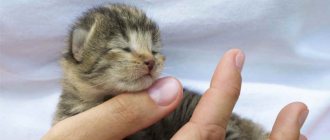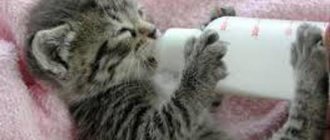If you've brought home a new baby, you may be nervous about how to introduce your cat to the new family member.
Luckily, cats and babies can live happily together, but it will take some preparation to ensure everything goes smoothly.
Just like setting up your home for the birth of a child, it is important to prepare your cat for the upcoming changes as early as possible.
Proactive preparation will relieve you and your cat of stress and unwanted behavior problems so the whole family can live in harmony.
- How to prepare a cat for the arrival of a baby in the house Follow health precautions
- Make gradual changes
- Don't play games with your hands
- After the birth of a child, be sure to:
- Important points to consider:
How to prepare a cat for a baby's home
There are several points that will help your cat go from being the only pet to a family with a new baby.
These items may include the following rules:
Take health precautions
As a cat owner, you may have heard of toxoplasmosis. Toxoplasmosis is a parasite that can be transmitted from cats to humans. It can also be passed from mother to unborn baby.
This parasite causes many diseases in the unborn child, such as blindness, deafness or hydrocephalus.
To prevent the spread of this parasite from cat to person, avoid stray cats and keep your cat indoors.
Be sure to wear gloves when working with your cat's litter box, litter bins, or gardening.
Make gradual changes
When preparing a home for a newborn, it is important to spend a lot of time with your cat, preparing her for life with a baby.
How to choose the cat breed most suitable for small children
When getting a cat, you should initially think about how it will get along with a newborn baby. Only correct calculation and proper behavior of the owner can make it so that in the future two kids will get along very well with each other and this will not cause any trouble to anyone.
“Thus, when purchasing a kitten, you need to think less about its preferences, and think about how its breed will affect the relationship with your future child.”
Choosing a cat is a very responsible process that must be done consciously. The most basic rule is the health of your cat, as this is necessary so that you do not have any problems with him in the future.
Thus, you need to pay attention to the following criteria for the correct choice of your future pet based on the fact that he will need to get along with the newborn baby:
- The most ideal cat breeds are those that are not afraid of anything from infancy. If the baby behaves without fear and feels confident enough, then in the future he will adapt perfectly to all new circumstances.
- When choosing a kitten, you need to watch how he plays with his brothers and sisters. If the kid you have chosen is the most cocky and active, then this will not be the best option for the establishment, since he will always try to be a leader, and for the child this will not be the best option.
- Starting from two months of age, the baby should be interested in everything independently. The most ideal option is when the cat chooses its owner.
- External indicators of a cat’s health are the most important thing that you need to pay special attention to. His coat should shine and glow with health, his teeth should be white, his ears should be clean. Only on this basis can we conclude that the animal is healthy and will be the best option for sharing a living space with your baby.
Cats and small children can be best friends if you approach the process of getting to know them and further relationships correctly and responsibly.
Follow these steps to help your cat adjust smoothly:
Don't play games with your hands
If your cat is used to playing games with his hands, stop this as soon as possible.
Even a gentle cat can scratch your baby by mistake. Teach your cat that only toys are suitable for play.
Get your cat used to baby sounds
In the months leading up to your baby's birth, prepare your cat for these new sounds by playing recordings of gurgles, coos and—yes—even screams throughout the day.
Start quietly and increase the volume as your cat gets used to the new sounds. To avoid stressing your cat, do this process gradually.
Bring baby smells and objects into your home
Cats rely heavily on scent, so the scent of a baby and new objects can frighten a cat.
Bring baby powders, shampoos and formulas into the house to help your cat adjust before the baby is born.
Placing baby product scents on your skin and clothing can help your cat develop positive associations with the new scent.
If there are a lot of cats
Of course, many people purposefully have cats at home, most often buying famous breeds for divorce. But many simply pick up kittens thrown away by someone or even adult cats that, by the will of fate, ended up on the street. As a rule, this entire flock gets along peacefully with each other.
And he perceives a person as an external strong animal that feeds, cares and caresses. The appearance of a new living creature, which is not much smaller in size than the cats themselves, raises almost no questions for them; on the contrary, animals must immediately be taught not to do the following :
- do not jump into the crib, stroller, table where the baby is swaddled;
- do not interfere with the owners during feeding;
- train the cat not to enter the room where the child is.
It is quite possible to establish this relationship between cats and cats, since this animal is smart and understands its place in the house. Having become accustomed to these basic rules, cats react completely calmly to newborn children.
How to introduce a child and a cat
When you come home from the hospital with your newborn, there may be a lot of new things going on - visitors, gifts, new routines.
But it is important that you take the time to introduce the baby and the cat to each other.
After the birth of a child, be sure to:
Set aside quiet time—just you, kitty, and baby—to greet each other peacefully. Give your cat quiet time to bond with you and your newborn.
Give the cat a child's object to explore
Use a baby blanket or piece of clothing in a quiet, safe place where your cat can explore at his leisure. This will help your cat get used to the baby at a pace that is comfortable for her.
Supervise when the cat and child are together
Cats love to snuggle, but this can be dangerous if your newborn can't move his head yet. Always keep the door closed unless you can look after the baby and cat together right away.
What are they afraid of?
Why does such a problem appear before the birth of a child: cats and newborn children. There are several reasons :
- possible allergy to cat fur; according to statistics, this pathology occurs quite rarely, but if such a situation arises, the animal can always be isolated;
- a cat can become a spreader of infection, but only if it lives both at home and outside.
© shutterstock
The last one is very significant. There is a common belief that cats should be allowed outside. But this is not so, because this is a domestic animal for which the territory that it controls is important, in this case, this is the area of the apartment or house. Side factors that encourage a cat to go outside can easily be overcome: by sterilization, at least of the cat, and drug intervention (sedative drops) for the cat.
This procedure is completely painless for a cat, and for a person’s conscience it is absolutely calm, since, having taken an animal to live in a house, we are obliged to fulfill some formalities, otherwise it is better not to take responsibility for the animal.
If we can’t arrange a cat’s life, then why are we trying to have a child? Communication between a cat and a newborn is inevitable after the baby appears in the house. These creatures are very curious, and having become members of the family, they are also jealous, so you need to prepare your pet for the arrival of a new resident of the house.
Rules to follow
- The animal must be examined by a veterinarian. Then the pet must receive the necessary vaccinations and prevent worms. In the future, this procedure must be carried out regularly under the supervision of a veterinarian.
- Maintain good hygiene. Remember that animals are potential sources and carriers of infectious diseases!
- Always wash your hands after handling your pet.
- Do not allow the animal to come into contact with the child’s things and toys. If this happens, wash your toys and wash your clothes. Moreover, close contact between the baby and the animal is unacceptable. Do not allow the animal to lick, sniff or touch the child. While the child is small, he cannot fully feel all the joy of communicating with an animal, but he will have time to become infected with some kind of infection. In the room where the child spends most of his time (sleeping, playing), it is forbidden to place cages with birds, animals and place dog and cat houses, as well as aquariums. Animals and the baby must live isolated from each other.
- Be more careful about keeping your home clean. Wet cleaning is recommended to be carried out daily, and if the need arises (pollution in the apartment, an abundance of hair during the animal’s molting period), then more often. It is necessary to ventilate the room several times a day. It is advisable that there is no specific animal smell in the room: this will help reduce the risk of allergic reactions.
- Never leave a small child alone with an animal. This is a potentially traumatic situation, because the behavior of both is unpredictable. A sudden cry or involuntary movement by a child can frighten the animal or cause it pain. While defending itself, the animal may bite and/or scratch the baby. In addition, an animal, such as a cat, can lie next to a sleeping child in such a way as to cause suffocation in the baby.
Whether or not to have an animal in the house is something everyone decides for themselves. But approach this important decision thoughtfully, taking into account all the positive and negative aspects.
Natalia Taishcheva, Ph.D. honey. Sciences, Assistant, Department of Hospital Pediatrics, Russian State Medical University
Other types of pets and their danger to the baby
It is better to keep pet parrots away from the nursery, at least in the first years of the child's life. Birds can lead to a variety of chlamydia-related diseases. The most common among them is psittacosis , which causes a dry cough, fever and even pneumonia.
Small rodents in the house can cause a baby to become infected with scabies . The disease, which manifests itself as severe itching, is transmitted by direct contact through the bites of scabies mites. Like cats and dogs, hamsters can cause helminthiasis.
Protection function
Not only dogs, but also cats can act as protectors in certain situations. But in this context, another aspect is much more important. The favorable development of a child’s relationship with a pet in itself makes him more confident and resistant to fears. Having a close friend nearby can also minimize the impact of stress. Moreover, these positive effects will persist and acquire new qualities as the child grows up.
Element of unpredictability
Precautionary measures must also be observed. An animal is an animal, and it will always be unpredictable to a certain extent. It is advisable that the child has his own space (ideally a room) where the kitten will not get into.
New research from China: what will happen to your teeth if you don’t brush them for 24 hours
Why is the cat so important? The real reasons why cats ignore their owners
A British cruise ship appears to be floating above the water: an optical illusion
The dating process should take place gradually and under the supervision of adults. As your child gets older, signs of an animal's displeasure, such as a wagging tail or hissing with his ears flattened, need to be explained to him.
Benefits of having a pet
A kitten can give a child a lot, which is confirmed by surveys of the owners themselves. For example, a pet can teach a child compassion and stimulate a sense of responsibility.
There are also obvious benefits for the animal itself. Cats receive a lot of love from children, and sometimes even real care. Moreover, some children perceive pets as friends. A kitten may well be your very first friend in life. A child can communicate with a cat in a way that he cannot even communicate with people. This manifests itself not only in games, but also in the same empathy, sharing feelings and showing emotions.
British cats, pregnancy, children.
Our British cat is named Tesla, after the famous scientist. He has been living in our family for two years. During this time, a second child appeared in the family. In my review, I want to talk about the relationship between a cat and children, and in general about the nuances of keeping an animal at home that we encountered.
We bought a cat at the age of 2 months, for five thousand rubles, with documents. We agreed with the breeders that the cat is not for breeding; this is also written in the documents. I bought the cat just for fun, I liked the color, and I never needed the documents, they are still lying somewhere in the far corner of the house.
This color is called marbled because of the characteristic stripes. On the forehead of purebred marbled Britons, stripes form the letter M, on the shoulders there is a pattern in the form of a butterfly. A more detailed description of the breed can be read below.
The head is round and with well-developed cheeks, wide at the cheekbones, which emphasize its round shape. The neck is short and thick. The nose is short, wide, straight. In profile, the round forehead turns into a short, straight nose (the transition should not be very obvious, but noticeable). The chin is strong and level. The nose and chin are vertical.
The ears are small, rounded, low and wide set.
The eyes are large, round, wide open, set wide apart. Usually a very bright orange color. Point cats have blue eyes. Chinchillas range from blue, lavender, to emerald green.
The body is squat, cobby-type, the back is straight and short. The chest is wide. Shoulders are broad and massive
Legs and paws - the legs are short, thick, the paws are round, strong, dense.
The tail is thick, of medium length, rounded at the end, wide at the base.
The coat is short, thick, shiny, dense, fine texture, non-lying, with a thick undercoat. A coat that is too soft and/or too long and/or close-lying is a fault.
The British Fold breed does not exist. There is a "British Shorthair (longhair)" and a Scottish Fold.
This is the first cat in our family. The cat quickly took root, he was very active, at first we thought that Tesla would destroy our apartment, he ran around the house all day long and jumped everywhere. Once he jumped from the balcony, from the third floor, they took him to the veterinarian, thank God everything worked out, then he hit his eye on the corner, during the jump, they barely saved his eye. The cat was accustomed to the litter box right away, but he finally got used to the scratching post only after a couple of months, during which time he tore up the wallpaper and some furniture.
Nutrition
Until a year they fed Tesla Royal Canin for British kittens, then Royal Canin for British kittens. For the last few months, there has been a catastrophic lack of money, since I am on maternity leave. We give hypoallergenic food Our brand and our meat food. Dry food is normal food for cats, if it is of high quality; there is absolutely no time to cook for the cat yourself. We tried to give the cat dry Whiskas, but he immediately developed an allergy to it, the smell of feces was terrible. So, if you have a British cat, it is advisable to buy special food at a pet store or make it yourself, the recipe for a balanced food is quite complex, it can be found on the Internet.
Castration
At 8-9 months, the cat’s urine began to smell very strongly, not a single litter masked this smell, and one urination was enough for the whole apartment to smell. We decided to castrate the cat. When we brought him to the doctor, it turned out that our cat had cryptorchid. Cryptorchidism is a condition where the testicles are out of place. In our case, both testicles were in the abdominal cavity; if we had not performed the operation, the cat could have developed cancer. After castration, the smell of urine almost completely disappeared and now we change the litter in the tray every 3-4 days. We use regular pine filler. After castration, the cat stopped growing and always weighs about 4.5 kg. Although the operation may not be related to growth, I cannot say for sure. In general, the average weight of an adult Briton is about 6 kg, while that of a cat is 4-5 kg.
Wool
Another problem we encountered was fur; in the spring the cat began to shed hair and there was fur everywhere. The British have a medium-long coat, but as a rule it is very thick, densely packed, and a lot of it falls out when shedding. Good food and vitamins did not help us. My husband generally hates dust and fur, so at the beginning we bought different brushes and a vacuum cleaner. They scratched and vacuumed every day, but this didn’t really help. The husband began to lash out at the cat, the mother-in-law came and added fuel to the fire. I solved the problem simply - I took it to a groomer (animal hairdresser) and cut the cat like a lion. We didn’t feel any fur at home at all - for two months, then we cut it again, such a service costs 1000 rubles, but you can learn how to cut it yourself.
Cat and pregnancy
The fact is that at the time the cat moulted, I was pregnant and my relatives began to whisper to me that I needed to get rid of the animal, as if it might infect me and the child with something. I was categorically against it. The fact is that cats can infect humans with toxoplasmosis. For an ordinary person, this disease is not dangerous, but for a fetus during pregnancy it poses a mortal threat. Domestic cats can become infected with toxoplasmosis through raw meat, so it is best to feed them store-bought cat food if you are pregnant. A test for the presence of toxoplasmosis can be taken at any clinic, even at a regular provincial antenatal clinic. Such an analysis will show not only the presence/absence of toxoplasma, but also whether you have had this disease before or not. It turned out that I had already suffered from this disease a long time ago, and since re-infection is not possible, I could no longer infect the fetus. In general, the cat turned out to be safe for the fetus, the fur disappeared after the haircut and my relatives stopped harassing Tesla. By the way, toxoplasmosis is deadly, not only for the fetus, but also for HIV-positive people.
Cat and children.
By the time the cat appeared, I already had one child - 4 years old. Tesla turned out to be a good friend for him, they still play, they even tell us that our eldest son and the cat are somewhat similar. At the time the cat appeared, my son had a stutter, he was afraid of animals, but he became friends with the cat and over time, our stuttering went away. Of course, we were treated with medication, went to a neurologist, worked with specialists, but I think the cat also contributed to his son’s treatment. Then I had my second baby. At first we were afraid that the cat might scare him and become jealous, but Tesla treated the child well and watched him carefully from the first days. He loved to lie down next to him when the child was lying on the sofa, he tried to lick the baby, but I stopped it. When the child grew up, the cat began to bring him toys. Kiss was the first word the baby said. When the child crawled, another problem appeared; he began to climb towards the litter box and the cat’s bowl. You have to close the toilet and put the bowls out of reach of the child, most often on the windowsill. It’s good that the cat screams when he wants to go to the toilet, but he still shit near the toilet a couple of times when we forgot about him. The child is still small, a little over a year old, sometimes he bullies the cat, but Tesla quickly calms him down, waves him off with his big furry paw, but never lets out his claws. The cat loves children very much, follows them around, especially the youngest. This is despite the fact that they sometimes like to beat him up. This is our mustachioed nanny.
Relationship between cat and baby. As soon as a baby appears in your home, your attention completely switches to him. If a cat already lives in your house, then it is very difficult to immediately understand the pet’s attitude towards the new family member. At first, you need to make sure that the cat does not stay with the child without the presence of adults and does not enter his room.
However, you should introduce your pet to the baby in the first days of his life. To do this, you can let the cat sniff the baby’s things so that she can make sure that the child does not pose any threat. It doesn’t hurt to visit a veterinarian to rule out fungal and other diseases in the cat that could pose a danger to the child’s developing immunity. This is also useful for determining whether your baby is allergic to cat hair. Nowadays, allergies in children are very common, and in this case, most likely, you will have to get rid of the animal.
During the period when the child begins to crawl, it is necessary to ensure that attempts to play do not seem to the cat to be a manifestation of aggression, and she does not attack your child. Parents of children of this age often complain that the child was scratched.
Cat and older children
As soon as children grow up to the age when they can independently control their behavior, it is necessary to explain to them that the animal also deserves respect and careful treatment. The cat litter box and food area should be off-limits for the child. Children should not be left alone with animals.
It is worth noting that communicating with a furry friend at an early age is very beneficial. If you don’t have a cat yet, and you are just planning to adopt one, then it is best to take a small kitten. This way they will grow, develop and look after each other together. Such communication will help the baby become more independent. Over time, he will understand that animals must be treated with great care.
It is very important to explain to your child that a cat is not a toy. Very often, children torture cats by dragging them from corner to corner, dressing them in doll clothes, or playing for too long. In this case, the animal may show aggression and adults must prevent this.
The dangers that cats keep within themselves
Domestic cats can also spread dangerous diseases. By eating raw fish and meat, hunting flies, and walking near outdoor shoes, cats can contract helminthiasis (worms) and so on. In cats, this disease is asymptomatic, but the risk of spreading this disease to people, and especially children, is quite high. To avoid this situation, parents must carry out worm prevention at least 2 times a year.
The animal can also become infected with toxoplasmosis, which is extremely dangerous, especially during pregnancy. An expectant mother can become infected with toxoplasmosis while cleaning the cat's litter box. This disease in itself is not dangerous for the mother, but can have a detrimental effect on the development of the fetus.
The next disease, which is not life-threatening, but quite unpleasant, is ringworm. Infection occurs through direct contact with a sick cat. In case of infection, a person develops scaly spots that have a round shape. To prevent you and your child from becoming infected with this disease, your pet should be vaccinated.
The most dangerous disease carried by cats is feline rabies. This disease is caused by a neurovirus, which is transmitted through a bite with saliva. The disease is incurable and if symptoms are detected, you should immediately consult a doctor.
Cats can also cause a disease called cat scratch. This disease is infectious, and it occurs when bacteria enter the baby’s injured skin. The disease is spread by cats whose bacteria are located in the oral cavity. By licking your paws, the infection gets to your claws. Infection of a baby can occur when a cat bites or scratches it. At the site of the bite or scratch, a spot appears, and then a blister, which subsequently bursts and forms an ulcer. Next, the lymph nodes become enlarged and the temperature rises. Treatment takes place at home with plenty of fluids and antipyretics.
It is worth noting that cats can be carriers of other diseases, such as salmonellosis or chlamydia. If your pet shows any signs of illness, it is better not to approach the animal and protect it from contact with children.
How do you get along with children?
Such a pet will enjoy communicating with the baby.
Sphynxes are very good with children because they themselves do not grow up. Felinologists believe that cats of this breed are excellent nannies who will not only play, but also take care of the child. Together they will make an ideal tandem and give parents the opportunity to relax. For cats, the intrusiveness of children will only be a joy. But the exception is very young children under 1 year old. A newborn may suffer from excessive care and curiosity of the animal. There are often cases when an interested pet frightens the baby or damages the skin due to an attempt to lick. The special rough structure of the tongue is not dangerous for adults, but provokes irritation in children. The Sphynx is also good for families with children because of its lack of fur. The child’s play space will not have to be constantly vacuumed and tidied. Research by felinologists has found that a child who has contact with a cat from an early age learns faster, masters sensory skills, develops reaction and empathy. Thanks to the activity of the animal, the child will also get to his feet faster and will actively burn energy during joint games. Sphynx cats rarely cause allergies, but despite the lack of fur, it is better to first make sure that there is no negative reaction from the body. Enzymes released through the skin can cause rashes, redness, coughing and sinus congestion in sensitive people. Symptoms may be mistaken for a cold, so the doctor should be notified of the appearance of a pet.
How can cats be dangerous for a baby?
Cats are capricious creatures and practically impossible to train, so their contact with a newborn must be stopped so that the baby does not catch felinosis . Cat scratch disease is infectious in nature and manifests itself in prolonged healing of scratches from claws, an increase in temperature and an increase in the size of the lymph nodes in the armpit area. Treatment of felinosis is often delayed, and it must be monitored by a pediatrician.
Another common disease in cats is toxoplasmosis . This infection is not dangerous for healthy children and adults, since its symptoms do not appear in any way, and once acquired immunity lasts for life. Only HIV-infected people or patients undergoing chemotherapy whose immunity is severely weakened can feel the symptoms of toxoplasmosis.
Toxoplasmosis poses a real danger only to pregnant women who have not developed immunity to this type of bacteria. If a woman is infected with Toxoplasma bacteria during pregnancy, they cause serious damage to the nervous system of the fetus, which reduces the chances of having a healthy baby to zero.
Toxoplasmosis - should you be afraid?
Given this risk, when planning pregnancy or in the early stages, you need to take an enzyme-linked immunosorbent test, which will detect the presence of immunoglobulins in your blood that can protect your child from congenital toxoplasmosis.
Don't worry if
But in these cases, on the contrary, there is no reason for concern. All that is required on your part is patience and feeding.
- The cat has slight bleeding from the genitals. Gradually their volume should decrease and disappear within 2-3 weeks.
- The kitten has only one eye open. This is considered a variant of the norm; the eyes open gradually and not always at the same time.
- The cat lies down on the kittens. In this way she tries to warm them up. Don't interfere, just try to maintain the optimal temperature in the room.
- The mother decided to move the kittens to another place, taking them by the withers. Don’t interfere with her, just make sure that the new “home” is as comfortable as possible, far from noise and people, and that the cat herself feels good.
Elena Shlykova











